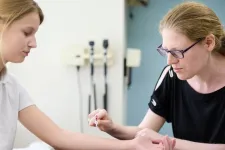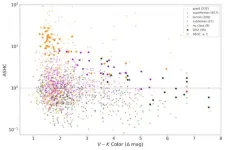(Press-News.org) A migraine is not just a bad headache. It is a much-dreaded part of a neurologic disorder that has an array of possible symptoms, including pulsating cranial pain, waves of queasiness, bouts of vomiting, and hypersensitivity to light and sound. They frequently materialize unannounced and at the most inopportune of moments.
Pubescent girls with a family history of migraine headaches are especially vulnerable — yet there remain many unknowns regarding the who, when and why of the disorder. Hadas Nahman-Averbuch, PhD, a scientist at Washington University School of Medicine in St. Louis with expertise in pediatric pain and migraine disorder, is trying to change that. She is leading two observational studies: One will examine why some adolescent girls develop migraine headaches and others do not, and the other will explore how puberty plays a role in migraine headaches among boys and girls.
The single-center studies at the School of Medicine are supported by two grants totaling $6 million from the National Institutes of Health (NIH).
“During adolescence, we see a significant increase in the prevalence of migraine diagnoses in girls,” said Nahman-Averbuch, who runs the Pain Across the Lifespan lab at the university and is an assistant professor of anesthesiology. “We want to understand the changes that come before migraine headache onset and identify the girls who are at risk of developing them. The hope is that this knowledge leads to new therapies and interventions that, if given early, could prevent, manage or treat migraine headaches in adolescent girls.
“We also want to investigate how puberty affects the severity and incidence of migraine headaches in adolescent girls and boys who already experience them, to better understand the trajectory of the disorder.”
Treatments for young migraine sufferers are limited — newer migraine medications that have hit the market in recent years are limited to those 18 and older — and more research into the often-debilitating condition in adolescents is needed.
Among the issues in getting to the bottom of why migraine headaches occur are the many triggers: among them, stress, certain foods, sleep deprivation, caffeine and fluctuating hormones. On top of that are the wide-ranging and inconsistent time delays between triggers and migraine headache onset, which complicate pinpointing a migraine’s exact cause.
The first study led by Nahman-Averbuch focuses on 200 girls ages 10 to 13. During three visits, study participants undergo magnetic resonance imaging (MRI) to look at brain connectivity between two brain regions – the amygdala and the prefrontal cortex. The amygdala plays a critical role in how we perceive and respond to pain. It communicates and interacts with the prefrontal cortex. Changes in that interaction are found in patients with migraine headaches compared with those without migraine headaches and are linked with changes in headache frequency in adolescents with the disorder, Nahman-Averbuch said.
Girls with a family history of migraine disorder are compared with girls without such history to determine if brain changes can be used to predict who will be diagnosed with the illness. The girls, migraine-free at the start of the study, are monitored for migraine development for two years.
Adolescents who have a first-degree relative with migraine disorder have been found in previous work to have higher sensitivity to pain. Nahman-Averbuch, who was involved in such research, suspects that a heightened response to sensory testing involving heat, cold and pressure stimuli may predict who will be diagnosed with the disorder. The participants rate such experiences as part of the study.
Migraine headache incidence is higher in boys before puberty and in girls during puberty, when fluctuating sex hormones aid in the transition to early adulthood. The researchers seek to figure out if a particular sex hormone – for example, estrogen, testosterone or progesterone – can help predict why adolescent girls are more likely to be affected. The research team is monitoring blood levels of various sex hormones as part of the study.
“There are many changes – biological, psychological and social – happening during puberty,” Nahman-Averbuch said. “Each could impact the pain system and be responsible for this pattern. We want to figure out what those changes are, and if they can predict who is at risk of developing migraine headaches.”
In the second study, the researchers track 180 girls and boys ages 10 to 13 diagnosed with migraine disorder over two years. Migraine-free boys with no family history of migraine disorder and migraine-free girls from the first study are part of the control group. Using the same methods as in the first study, the researchers look at how puberty impacts migraine headaches.
“Understanding the changes that come before migraine headache onset and the changes during puberty that improve migraine disorder in a certain population can help us develop new interventions and preventive strategies,” Nahman-Averbuch said. “Meanwhile, identifying adolescents who are at risk may allow us to start such interventions earlier.”
END
Can we predict who will develop migraine headaches?
Adolescents focus of research on brain connectivity, hormones, pain sensitivity in determining migraine risk
2024-07-22
ELSE PRESS RELEASES FROM THIS DATE:
On the origin of academic traditions — and some alternatives for debate
2024-07-22
(Santa Barbara, Calif.) — The field of science aims to be objective, repeatable and justified in its choices and methods. These principles are what distinguish accepted scientific findings from pseudo-science. Yet the experience of learning and working in the field of science, including graduate school activities and scientific conferences, might not always follow the same principles. These practices and gatherings of scientists may be just as organic and random as evolution.
Have the traditions of science — rituals of poster presentations and tenure positions — evolved by chance? ...
Tropical plant species are as threatened by climate change as widely feared, study confirms
2024-07-22
PROVIDENCE, R.I. [Brown University] — Brown University biologists who set out to better understand the effects of climate change on plant species in tropical mountain regions found that even small variations in temperature and moisture can have massive impacts, threatening not only plants that live there, but also the ecosystems they support.
Emily Hollenbeck, who conducted the research while earning her Ph.D. in ecology and evolutionary biology from Brown, made the discoveries through a series of laborious yet informative experiments conducted in the Monteverde mountain ...
SNIS 2024: New study shows updated stroke evaluation protocols increase patient access to lifesaving stroke treatment
2024-07-22
COLORADO SPRINGS, Colo. — Changing standard procedures for evaluating and treating patients with suspected stroke has led to improved access to lifesaving stroke surgery across the state of Delaware and should inform triage and treatment nationwide, according to research released today at the Society of NeuroInterventional Surgery’s (SNIS) 21st Annual Meeting.
In “Direct From the Field Bypass to CSC Improves Timeliness and Likelihood of Thrombectomy for Patients with Emergent Large Vessel Occlusion,” the members of the Delaware Stroke System worked with the state’s emergency medical services (EMS) director ...
Development of ‘living robots’ needs regulation and public debate
2024-07-22
EMBARGOED: NOT FOR RELEASE UNTIL 8PM UK TIME (3PM EASTERN TIME) ON 22 JULY 2024
Development of ‘living robots’ needs regulation and public debate
Bio-hybrid robotics creates unique ethical challenges, say researchers
Researchers are calling for regulation to guide the responsible and ethical development of bio-hybrid robotics – a ground-breaking science which fuses artificial components with living tissue and cells.
In a paper published in Proceedings of the National Academy of Sciences a multidisciplinary ...
Ore-some: New date for Earth's largest iron deposits offers clues for future exploration
2024-07-22
Research led by Curtin University reveals that Earth’s largest iron ore deposits – in the Hamersley Province of Western Australia – are about one billion years younger than previously believed, a discovery which could greatly boost the search for more of the resource.
Using a new geochronology technique to accurately measure the age of iron oxide minerals, researchers found the Hamersley deposits formed between 1.4 and 1.1 billion years ago, rather than 2.2 billion years ago as previously estimated.
Lead author Dr Liam Courtney-Davies, who was a Postdoctoral Research Associate at Curtin University’s John de Laeter ...
Political campaigns can induce stress in minorities
2024-07-22
How did the 2021 national marriage equality referendum campaign in Switzerland affect the well-being of the LGBTIQ+ community? A team led by researchers at UZH has shown that LGBTIQ+ individuals and their cisgender heterosexual allies exhibited more stress hormones during the controversial campaign.
Lesbian, gay, bisexual, trans, intersex and queer (LGBTIQ+) individuals face persistent structural inequalities and discrimination that can adversely affect their well-being. When concerns of the LGBTIQ+ community are discussed in widespread public debates, such as during political initiative and referendum campaigns, that can ...
Rice researchers explore the effects of stellar magnetism on potential habitability of exoplanets
2024-07-22
Interest in Earth-like planets orbiting within the habitable zone of their host stars has surged, driven by the quest to discover life beyond our solar system. But the habitability of such planets, known as exoplanets, is influenced by more than just their distance from the star.
A new study by Rice University’s David Alexander and Anthony Atkinson extends the definition of a habitable zone for planets to include their star’s magnetic field. This factor, well studied in our solar system, can have significant implications for life on other planets, according ...
Lehigh University researchers awarded $1 million NSF grant to investigate floating offshore wind turbines
2024-07-22
In the past few years, we’ve seen a push toward renewable energy. One focus is wind, which is harvested via turbines–you may have seen them in mountainous areas, turning in the wind. But the United States’s most abundant wind potential lies offshore; wind speeds are highest off both coasts. This means offshore wind turbines promise high energy yields, akin to the offshore wind production in the North Sea near northern Europe.
But constructing wind turbine platforms in water deeper than ~60 meters presents problems. Turbines in shallow waters, like those in the North Sea, can be mounted on fixed-bottom platforms, held ...
SNIS 2024: New study reveals possible link between gastrointestinal syndromes and risk of brain aneurysm
2024-07-22
COLORADO SPRINGS, Colo. — There is a potential connection between a diagnosis of certain gastrointestinal (GI) syndromes and the formation and rupture of intracranial (brain) aneurysms, according to research presented today at the Society of NeuroInterventional Surgery’s (SNIS) 21st Annual Meeting.
An intracranial aneurysm (IA) occurs when a blood vessel in the brain bulges, putting pressure on the vessel wall. IAs that rupture cause brain bleeding and lead to a hemorrhagic stroke, a life-threatening emergency requiring immediate medical attention ...
More Black Americans die from effects of air pollution
2024-07-22
Everyone knows that air pollution is bad for health, but how bad depends a lot on who you are. People of different races and ethnicities, education levels, locations and socioeconomic situations tend to be exposed to different degrees of air pollution. Even at the same exposure levels, people’s ability to cope with its effects — by accessing timely health care, for example — varies.
A new study by Stanford Medicine researchers and collaborators, which takes into account both exposure to air pollution and susceptibility to its harms, found that Black Americans are significantly more likely to die from causes related to air pollution, compared ...
LAST 30 PRESS RELEASES:
Making lighter work of calculating fluid and heat flow
Normalizing blood sugar can halve heart attack risk
Lowering blood sugar cuts heart attack risk in people with prediabetes
Study links genetic variants to risk of blinding eye disease in premature infants
Non-opioid ‘pain sponge’ therapy halts cartilage degeneration and relieves chronic pain
AI can pick up cultural values by mimicking how kids learn
China’s ecological redlines offer fast track to 30 x 30 global conservation goal
Invisible indoor threats: emerging household contaminants and their growing risks to human health
Adding antibody treatment to chemo boosts outcomes for children with rare cancer
Germline pathogenic variants among women without a history of breast cancer
Tanning beds triple melanoma risk, potentially causing broad DNA damage
Unique bond identified as key to viral infection speed
Indoor tanning makes youthful skin much older on a genetic level
Mouse model sheds new light on the causes and potential solutions to human GI problems linked to muscular dystrophy
The Journal of Nuclear Medicine ahead-of-print tip sheet: December 12, 2025
Smarter tools for peering into the microscopic world
Applications open for funding to conduct research in the Kinsey Institute archives
Global measure underestimates the severity of food insecurity
Child survivors of critical illness are missing out on timely follow up care
Risk-based vs annual breast cancer screening / the WISDOM randomized clinical trial
University of Toronto launches Electric Vehicle Innovation Ontario to accelerate advanced EV technologies and build Canada’s innovation advantage
Early relapse predicts poor outcomes in aggressive blood cancer
American College of Lifestyle Medicine applauds two CMS models aligned with lifestyle medicine practice and reimbursement
Clinical trial finds cannabis use not a barrier to quitting nicotine vaping
Supplemental nutrition assistance program policies and food insecurity
Switching immune cells to “night mode” could limit damage after a heart attack, study suggests
URI-based Global RIghts Project report spotlights continued troubling trends in worldwide inhumane treatment
Neutrophils are less aggressive at night, explaining why nighttime heart attacks cause less damage than daytime events
Menopausal hormone therapy may not pose breast cancer risk for women with BRCA mutations
Mobile health tool may improve quality of life for adolescent and young adult breast cancer survivors
[Press-News.org] Can we predict who will develop migraine headaches?Adolescents focus of research on brain connectivity, hormones, pain sensitivity in determining migraine risk




